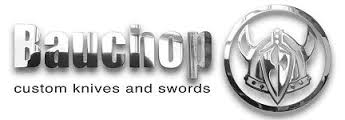A large shapely Bowie knife with Kalguard finish throughout.
Recurve Bowie
Looking for a no-nonsense heavy-duty blade that’ll probably outlast you?
The Bowie knife: this iconic fixed blade knife is thick with history and is said to have made appearances at the Alamo and in that classic film, “Crocodile Dundee.” Modern Bowie knives still have the DNA of their historical forefathers: they’re big knives, bold cutters and designed to get work done.
Robert Bauchop has developed into one of the most amazing world renowned Swordsmiths and taught his wife Karen the intricate art of knifemaking. They live in the inspirational setting of a small coastal town called Palm beach (nr Margate) on the Kwazulu-Natal South Coast with their son Blade and daughter Sabre.
Peter, Robert’s father also adds to the talented family whose knives take pride of place in many collector’s cabinets. Robert achieved a name for himself as a highly skilled and immensely talented artist in his field, his fascination with things magical and medieval, as well as his concern with the environment, have led to a collection of custom knives, daggers and swords which have received local and international acclaim for their superb finish, artistic merit and exquisite beauty.
A Bowie knife is a pattern of fixed-blade fighting knife created by James Black in the early 19th century for Jim Bowie, who had become famous for his use of a large knife at a duel known as the Sandbar Fight.
Since the first incarnation, the Bowie knife has come to incorporate several recognisable and characteristic design features, although in common usage the term refers to any large sheath knife with a crossguard and a clip point. The knife pattern is still popular with collectors.
The most famous version of the Bowie knife was designed by Jim Bowie and presented to Arkansas blacksmith James Black in the form of a carved wooden model in December 1830. Black produced the knife ordered by Bowie, and at the same time created another based on Bowie’s original design but with a sharpened edge on the curved top edge of the blade. Black offered Bowie his choice and Bowie chose the modified version. Knives such as this, with a blade shaped like that of the Bowie knife, but with a pronounced false edge, are today called “Sheffield Bowie” knives, because this blade shape became so popular that cutlery factories in Sheffield, England were mass-producing such knives for export to the U.S. by 1850, usually with a handle made from either hardwood, deer antler, or bone, and sometimes with a guard and other fittings of sterling silver. The James Black Bowie knife had a blade approximately twelve inches long, two inches wide, and 0.25 inch thick. The spine of the knife was covered with soft brass or silver, reportedly to catch the opponent’s blade in the course of a knife fight, while a brass quillion protected the hand from the blade.
In 1831 Bowie returned with his James Black Bowie knife to Texas, and was involved in a knife fight with three men armed with firearms, who had been hired to kill him by the man he had spared in his 1829 fight. According to reports of the time, Bowie used his knife to kill all three men: one assassin was nearly decapitated, the second was disemboweled, and the skull of the third man was split open. Bowie died at the Battle of the Alamo five years later and in death both he and his knife became an American legend. The fate of the original Bowie knife is unknown; however, a knife bearing the engraving “Bowie No. 1” has been acquired by the Historic Arkansas Museum from a Texas collector and has been attributed to Black through scientific analysis.
Black soon had a booming business making and selling these knives out of his shop in Washington, Arkansas. Black continued to refine his technique and improve the quality of the knife as he went. In 1839, shortly after his wife’s death, Black was nearly blinded when, while he was in bed with illness, his father-in-law and former partner broke into his home and attacked him with a club, having objected to his daughter having married Black years earlier. Black was no longer able to continue in his trade.
Black’s knives were known to be exceedingly tough, yet flexible, and his technique has not been duplicated. Black kept his technique secret and did all of his work behind a leather curtain. Many claim that Black rediscovered the secret of producing true Damascus steel.


